Abstract
1. We set out to test whether the signal from the heart that initiates the decompensatory phase of acute central hypovolaemia in conscious rabbits is conveyed by chemosensitive afferents. 2. Haemorrhage was simulated by inflating an inferior vena caval cuff so that cardiac output fell at a constant rate of 8% of its baseline level per min. After sham or vehicle treatments the haemodynamic response had two phases. In the first, sympathoexcitatory, phase systemic vascular conductance fell in proportion to cardiac output so that mean arterial pressure fell by only 13 mmHg. When cardiac output had fallen by approximately 50% a second, sympathoinhibitory, phase supervened. There was an abrupt rise of systemic vascular conductance and an abrupt fall of mean arterial pressure, to approximately 40 mmHg. 3. The sympathoinhibitory phase was prevented by injection of the delta-opioid antagonist ICI 174864 (100-300 nmol) or the mu-opioid agonist H-Tyr-D-Ala-Gly-MePhe-NH(CH2)2OH (DAMGO) (100-300 pmol) into the fourth cerebral ventricle. 4. 5-HT3 receptors on myocardial or pulmonary afferents were excited by injection of ascending doses of phenylbiguanide (6.25-400 micrograms) into the left or right atrium respectively. Neuronal-type nicotinic cholinoceptors in the epicardium were excited by injecting ascending doses of nicotine bitartrate (6.25-400 micrograms) into the pericardial sac. Each of these treatment regimens caused a reproducible, dose-dependent, fall in mean arterial pressure. Intravenous injection of the 5-HT3 antagonist MDL 72222 (1.0 mg kg-1) markedly attenuated the responses to phenylbiguanide.(ABSTRACT TRUNCATED AT 250 WORDS)
Full text
PDF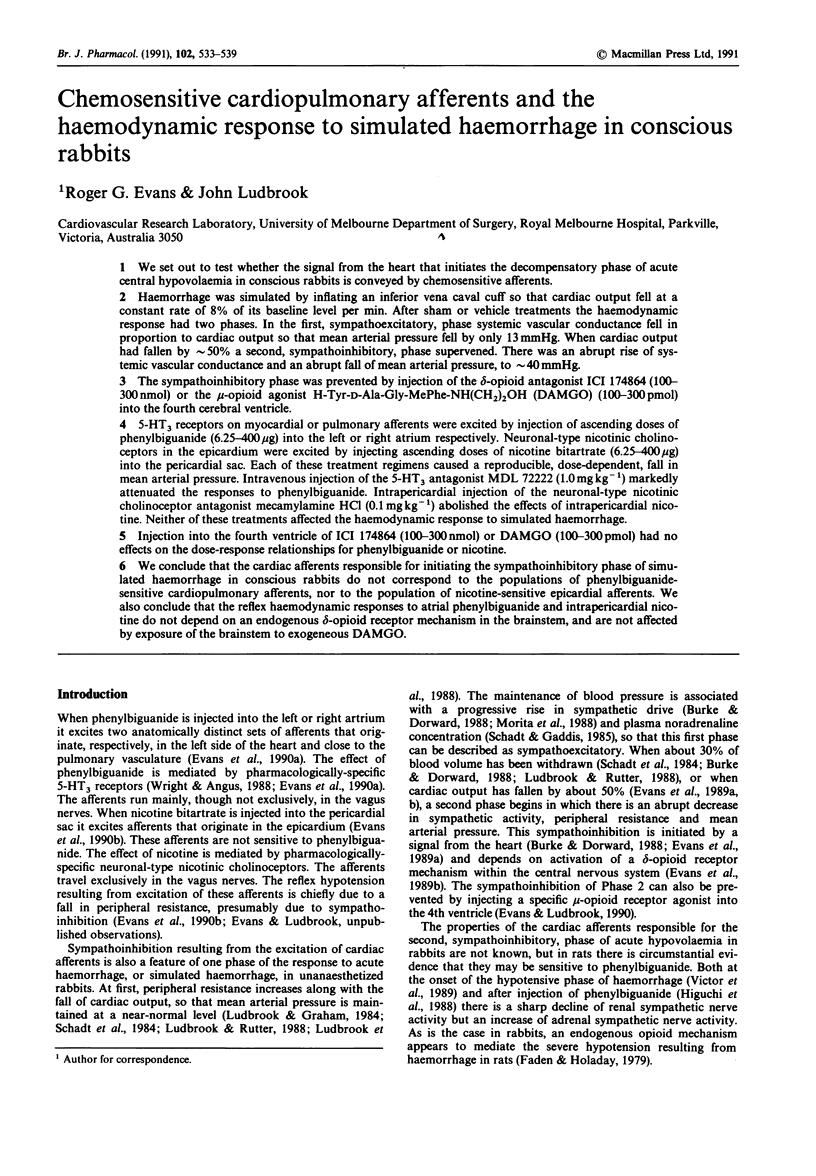
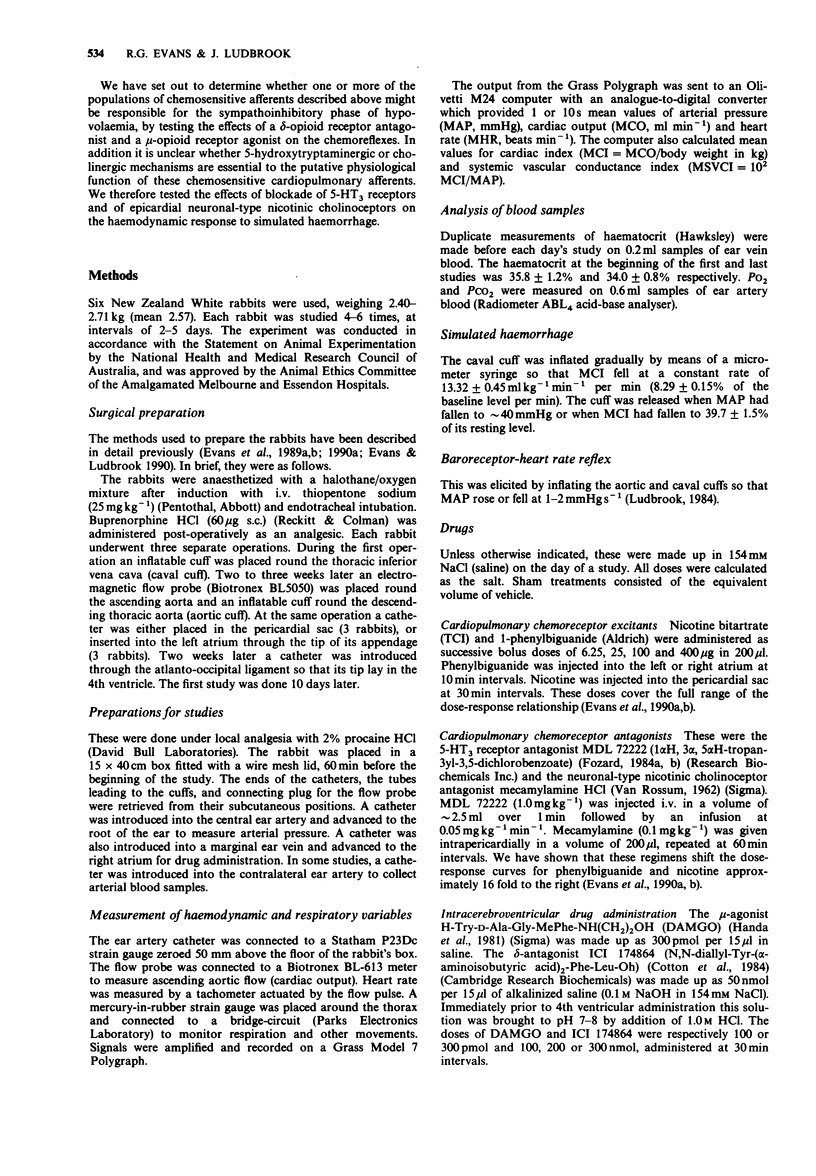
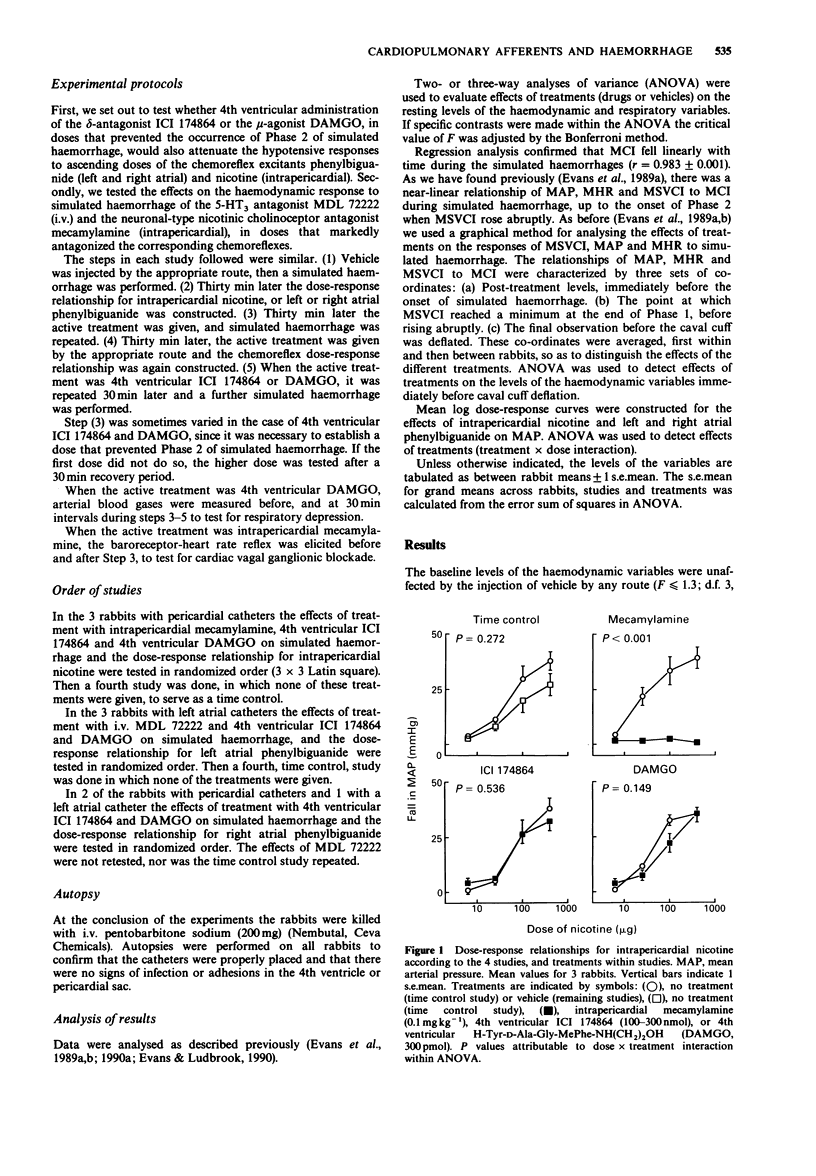
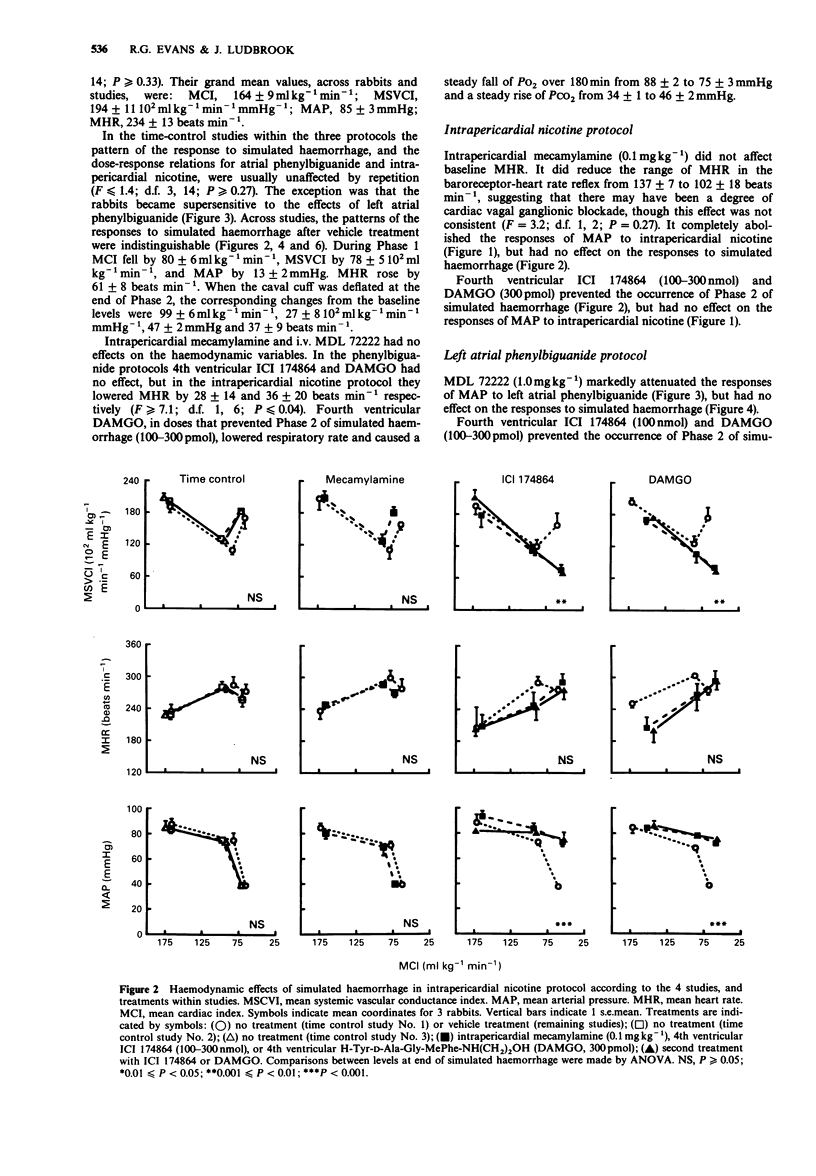
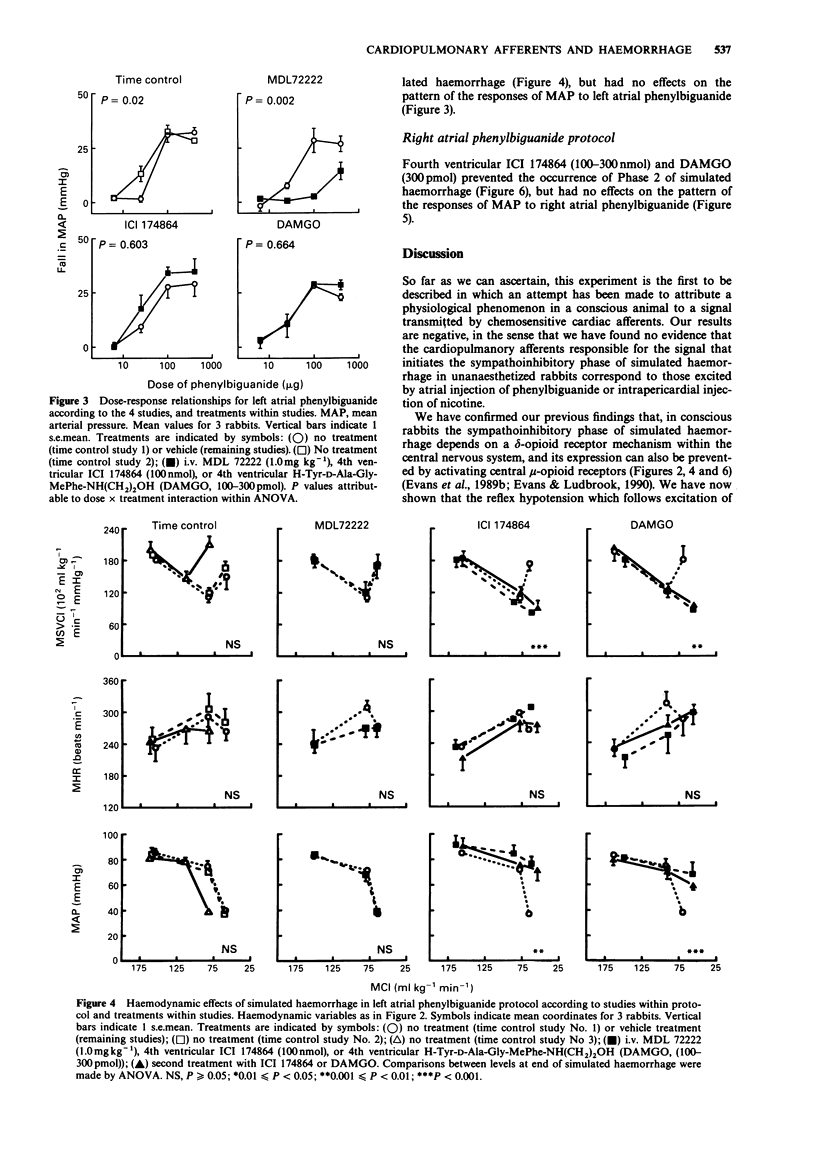
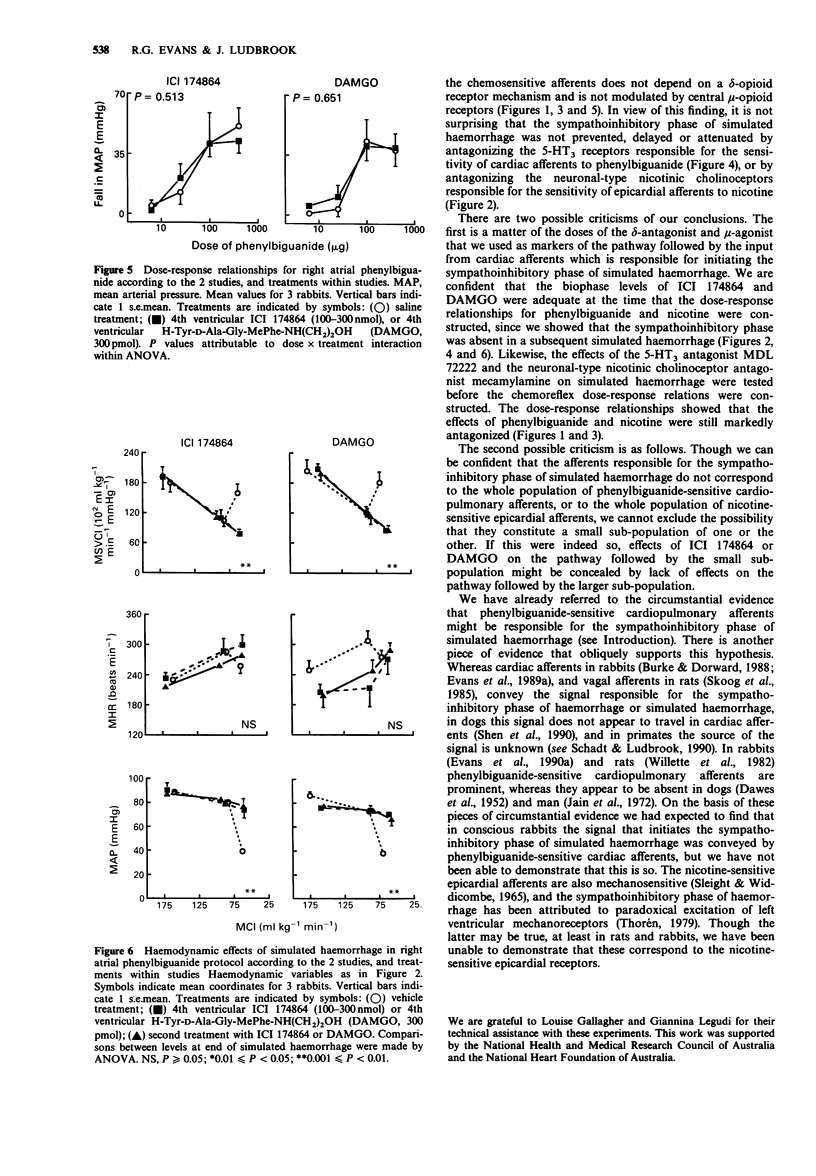
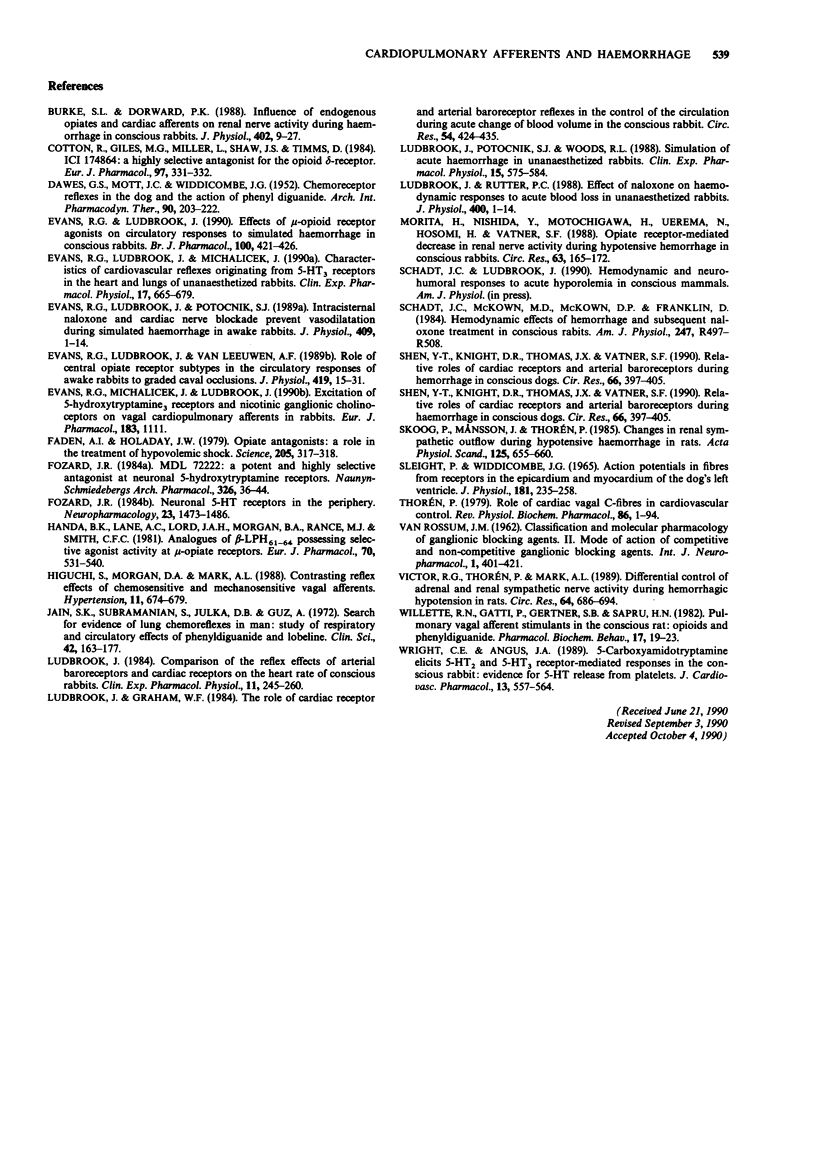
Selected References
These references are in PubMed. This may not be the complete list of references from this article.
- Burke S. L., Dorward P. K. Influence of endogenous opiates and cardiac afferents on renal nerve activity during haemorrhage in conscious rabbits. J Physiol. 1988 Aug;402:9–27. doi: 10.1113/jphysiol.1988.sp017191. [DOI] [PMC free article] [PubMed] [Google Scholar]
- Cotton R., Giles M. G., Miller L., Shaw J. S., Timms D. ICI 174864: a highly selective antagonist for the opioid delta-receptor. Eur J Pharmacol. 1984 Jan 27;97(3-4):331–332. doi: 10.1016/0014-2999(84)90470-9. [DOI] [PubMed] [Google Scholar]
- DAWES G. S., MOTT J. C., WIDDICOMBE J. G. Chemoreceptor reflexes in the dog and the action of phenyl diguanide. Arch Int Pharmacodyn Ther. 1952;90(2-3):203–222. [PubMed] [Google Scholar]
- Evans R. G., Ludbrook J. Effects of mu-opioid receptor agonists on circulatory responses to simulated haemorrhage in conscious rabbits. Br J Pharmacol. 1990 Jul;100(3):421–426. doi: 10.1111/j.1476-5381.1990.tb15822.x. [DOI] [PMC free article] [PubMed] [Google Scholar]
- Evans R. G., Ludbrook J., Michalicek J. Characteristics of cardiovascular reflexes originating from 5-HT3 receptors in the heart and lungs of unanaesthetized rabbits. Clin Exp Pharmacol Physiol. 1990 Sep;17(9):665–679. doi: 10.1111/j.1440-1681.1990.tb01367.x. [DOI] [PubMed] [Google Scholar]
- Evans R. G., Ludbrook J., Potocnik S. J. Intracisternal naloxone and cardiac nerve blockade prevent vasodilatation during simulated haemorrhage in awake rabbits. J Physiol. 1989 Feb;409:1–14. doi: 10.1113/jphysiol.1989.sp017481. [DOI] [PMC free article] [PubMed] [Google Scholar]
- Evans R. G., Ludbrook J., Van Leeuwen A. F. Role of central opiate receptor subtypes in the circulatory responses of awake rabbits to graded caval occlusions. J Physiol. 1989 Dec;419:15–31. doi: 10.1113/jphysiol.1989.sp017858. [DOI] [PMC free article] [PubMed] [Google Scholar]
- Faden A. I., Holaday J. W. Opiate antagonists: a role in the treatment of hypovolemic shock. Science. 1979 Jul 20;205(4403):317–318. doi: 10.1126/science.451606. [DOI] [PubMed] [Google Scholar]
- Fozard J. R. MDL 72222: a potent and highly selective antagonist at neuronal 5-hydroxytryptamine receptors. Naunyn Schmiedebergs Arch Pharmacol. 1984 May;326(1):36–44. doi: 10.1007/BF00518776. [DOI] [PubMed] [Google Scholar]
- Fozard J. R. Neuronal 5-HT receptors in the periphery. Neuropharmacology. 1984 Dec;23(12B):1473–1486. doi: 10.1016/0028-3908(84)90091-1. [DOI] [PubMed] [Google Scholar]
- Handa B. K., Land A. C., Lord J. A., Morgan B. A., Rance M. J., Smith C. F. Analogues of beta-LPH61-64 possessing selective agonist activity at mu-opiate receptors. Eur J Pharmacol. 1981 Apr 9;70(4):531–540. doi: 10.1016/0014-2999(81)90364-2. [DOI] [PubMed] [Google Scholar]
- Higuchi S., Morgan D. A., Mark A. L. Contrasting reflex effects of chemosensitive and mechanosensitive vagal afferents. Hypertension. 1988 Jun;11(6 Pt 2):674–679. doi: 10.1161/01.hyp.11.6.674. [DOI] [PubMed] [Google Scholar]
- Jain S. K., Subramanian S., Julka D. B., Guz A. Search for evidence of lung chemoreflexes in man: study of respiratory and circulatory effects of phenyldiguanide and lobeline. Clin Sci. 1972 Feb;42(2):163–177. doi: 10.1042/cs0420163. [DOI] [PubMed] [Google Scholar]
- Ludbrook J. Comparison of the reflex effects of arterial baroreceptors and cardiac receptors on the heart rate of conscious rabbits. Clin Exp Pharmacol Physiol. 1984 May-Jun;11(3):245–260. doi: 10.1111/j.1440-1681.1984.tb00262.x. [DOI] [PubMed] [Google Scholar]
- Ludbrook J., Graham W. F. The role of cardiac receptor and arterial baroreceptor reflexes in control of the circulation during acute change of blood volume in the conscious rabbit. Circ Res. 1984 Apr;54(4):424–435. doi: 10.1161/01.res.54.4.424. [DOI] [PubMed] [Google Scholar]
- Ludbrook J., Potocnik S. J., Woods R. L. Simulation of acute haemorrhage in unanaesthetized rabbits. Clin Exp Pharmacol Physiol. 1988 Aug;15(8):575–584. doi: 10.1111/j.1440-1681.1988.tb01116.x. [DOI] [PubMed] [Google Scholar]
- Ludbrook J., Rutter P. C. Effect of naloxone on haemodynamic responses to acute blood loss in unanaesthetized rabbits. J Physiol. 1988 Jun;400:1–14. doi: 10.1113/jphysiol.1988.sp017106. [DOI] [PMC free article] [PubMed] [Google Scholar]
- Morita H., Nishida Y., Motochigawa H., Uemura N., Hosomi H., Vatner S. F. Opiate receptor-mediated decrease in renal nerve activity during hypotensive hemorrhage in conscious rabbits. Circ Res. 1988 Jul;63(1):165–172. doi: 10.1161/01.res.63.1.165. [DOI] [PubMed] [Google Scholar]
- Schadt J. C., McKown M. D., McKown D. P., Franklin D. Hemodynamic effects of hemorrhage and subsequent naloxone treatment in conscious rabbits. Am J Physiol. 1984 Sep;247(3 Pt 2):R497–R505. doi: 10.1152/ajpregu.1984.247.3.R497. [DOI] [PubMed] [Google Scholar]
- Shen Y. T., Knight D. R., Thomas J. X., Jr, Vatner S. F. Relative roles of cardiac receptors and arterial baroreceptors during hemorrhage in conscious dogs. Circ Res. 1990 Feb;66(2):397–405. doi: 10.1161/01.res.66.2.397. [DOI] [PubMed] [Google Scholar]
- Skoog P., Månsson J., Thorén P. Changes in renal sympathetic outflow during hypotensive haemorrhage in rats. Acta Physiol Scand. 1985 Dec;125(4):655–660. doi: 10.1111/j.1748-1716.1985.tb07768.x. [DOI] [PubMed] [Google Scholar]
- Sleight P., Widdicombe J. G. Action potentials in fibres from receptors in the epicardium and myocardium of the dog's left ventricle. J Physiol. 1965 Nov;181(2):235–258. doi: 10.1113/jphysiol.1965.sp007758. [DOI] [PMC free article] [PubMed] [Google Scholar]
- Thorén P. Role of cardiac vagal C-fibers in cardiovascular control. Rev Physiol Biochem Pharmacol. 1979;86:1–94. doi: 10.1007/BFb0031531. [DOI] [PubMed] [Google Scholar]
- Victor R. G., Thorén P., Morgan D. A., Mark A. L. Differential control of adrenal and renal sympathetic nerve activity during hemorrhagic hypotension in rats. Circ Res. 1989 Apr;64(4):686–694. doi: 10.1161/01.res.64.4.686. [DOI] [PubMed] [Google Scholar]
- Willette R. N., Gatti P., Gertner S. B., Sapru H. N. Pulmonary vagal afferent stimulants in the conscious rat: opioids and phenyldiguanide. Pharmacol Biochem Behav. 1982 Jul;17(1):19–23. doi: 10.1016/0091-3057(82)90256-8. [DOI] [PubMed] [Google Scholar]
- Wright C. E., Angus J. A. 5-carboxamidotryptamine elicits 5-HT2 and 5-HT3 receptor-mediated cardiovascular responses in the conscious rabbit: evidence for 5-HT release from platelets. J Cardiovasc Pharmacol. 1989 Apr;13(4):557–564. [PubMed] [Google Scholar]


